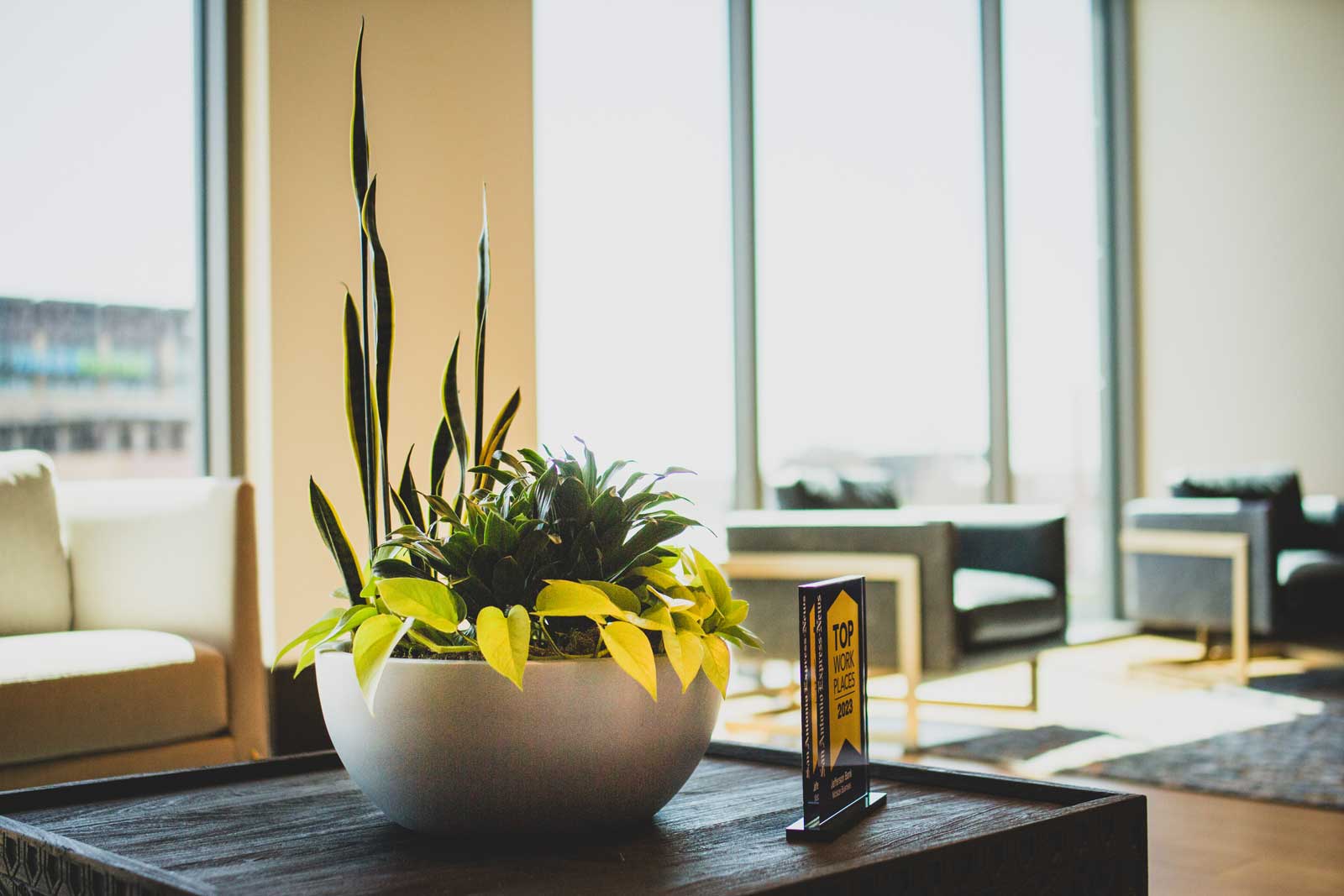Incorporating living plants into your office design does so much more than add to the aesthetics of the space. Here’s how enhancing your office environment with plants and greenery can positively impact the wellbeing of your workforce, as well as your bottom line.
How Indoor Plants Pack a Punch
It’s no secret that plant life impacts positively on the wellbeing of human beings. The positive effect of nature on people’s psyche has been well researched and documented, proving that people thrive in natural settings and have an innate desire to connect with and be around nature.
This is why, in a corporate environment, employees work best amongst greenery. Research has proven that incorporating living plants into the built environment makes for a happy workforce.
The Human Spaces report revealed that employees who worked in a space that featured natural elements were 6% more productive and 15% more content than their counterparts who operated in a plantless work space.
Those working in nature-filled environments also reflected a wellbeing score that was, on average, 15% higher than those who did not. Other studies have shown that people work 12% faster and are generally happier and less stressed when they’re surrounded by greenery.


A Positive Return on Investment
Global strides in information technology over the past few decades have enabled us to streamline work processes and speed up production lines. It’s also allowed for us to remain connected to each other, even remotely.
Many argue that the current digital revolution could only have increased productivity. However, it’s also resulted in the general working population spending 85% of their life at their desks. This has a direct impact on employees’ stress, anxiety and productivity levels, with 58% of employees who work indoors doing so in dull, lifeless, and unstimulating spaces.
The Physiological Benefits of Indoor Office Plants
It stands to reason that adding lush green life and living color will improve the general wellbeing of deskbound employees. According to Green Plants for Green Building, adding living plants to your office space works to:
- Reduce employee tension and anxiety by 37%,
- Lessen workplace fatigue by up to 38%,
- Cut chronic fatigue by nearly 40%,
- Mitigate office hostility by 44%,
- Lower depression rates by 58%, and
- Enhance creativity and increase productivity by 15%.

Incorporating nature into an office has also proven to reduce absenteeism by 14%. According to a 2007 study on the psychological benefits of indoor plants, those who worked in spaces with more plants were happier and more productive at work. They also took fewer sick days and recovered faster than those who worked in plantless environments.
This points to the marked physiological benefits of indoor plants, such as
- improved air quality,
- increased oxygen supply, and
- a reduction in air-borne toxins
Additionally, offices with more plant life play on people’s perception of air quality and healthy living spaces. This increases workplace productivity and satisfaction.
Improving Mental Health and Wellness
Aesthetically, plant life enriches the look of your office space by curating a tranquil ambience of calm, soothing serenity that’s been proven to reduce stress and anxiety, as well as improve concentration.
This supports the basic tenets of color psychology, following the notion that the color green promotes a grounded, calm and relaxed atmosphere – an atmosphere that could be extended to the workplace through the introduction of live plants and green walls.
Therefore, both psychologically and physiologically, office spaces that incorporate plant life into the built environment reduce downtime by subtly improving the general health and wellness of employees.
Lowering Unnecessary Energy Use: Reduce your Carbon Footprint
Besides the positive impact of office plants on employee health and wellness, adding indoor plants to a workspace can also improve a company’s operation and maintenance costs over time, This is because plants help spaces reduce their carbon footprint. They can help cool down a building, thereby reducing the need for air conditioners. This lowers a building’s energy use during a workday.
Thanks to photosynthesis, plants also release moisture in the air, and are therefore able to raise the humidity levels in a building to between 30% and 60%, which is the comfort range for humans. This also helps maintain the structural integrity of a building, as some materials (such as wood) can strain or crack when the humidity falls below the ideal comfort range.
Alternatively, when humidity exceeds the comfort range, the condensation on windows and walls can cause structural damage. This is why maintaining an ideal humidity level in a building can help to avoid costly and unnecessary repairs.
In terms of temperature, if there are enough indoor plants in a building, they can help lower the temperature by 50℉. One study shows that a single healthy tree can have the same impact as 20 air conditioners operating for 20 hours in a day. Following this premise, some larger species of indoor trees working together could offset the need to max out on your office AC. Plant life stands in as a more eco-friendly solution than an energy-guzzling aircon.
Increasing Workplace Productivity
Because of the countless positive effects that plants have on your health, emotional wellness and cognitive ability, interior designers have started incorporating biophilic design into their practice, and leaning on horticultural design experts like us to inform their work.

Biophilic design is the practice of integrating elements of nature into the built environment. It speaks to the innate need for human beings to interact or be surrounded by nature – a phenomenon also known as biophilia. It also speaks to why we are so driven and passionate about what we do.
According to the Human Spaces report (which delves into the global impact of biophilic design), up to one in five office workers globally have no natural elements in their workspace, with almost half of those surveyed reporting that they work with no natural light.
But we at Natura know that the benefits of indoor plants are far-reaching, which is why we work to enhance built environments with nature. Biophilia informs our mission: to curate environments where people are known to thrive.
Natura at Work: A Case Study in Biophilic Design
For a real life example, look at how we rejuvenated the DoubleTree Hilton Hotel in San Antonio, Texas using biophilic design. We revel in bringing old designs to life and enhancing not the look and feel of a space, We also love to hear how our services result in increased employee and customer satisfaction.
What we do gives clients significant return on investment by enhancing their brand image and status as healthy, eco-friendly establishments.More than that, we work to enhance the indoor environment for our customers, their employees and their clients.
In addition to:
- notably increasing productivity
- reducing stress and anxiety, and
- enhancing the creativity of those working in a plant-filled environment…
… bringing elements of nature into an office reduces noise pollution in a public or office space.

Eliminating Distractions: Neurodiverse Friendly Offices
Interior landscaping and indoor office plants do so much more than add life and color to what can often be a sterile environment. Large, strategically placed large pot plants around an office space work well to cushion sounds in noisy areas. But lush living walls (also known as green walls) are another efficient way to absorb white noise or other distracting sounds, like everyday office chatter.
Of course, you’d need to consider several key factors to determine whether a green wall would work in your office (factors like space availability, structure and lighting). But, if you’re able to make a success of your green wall, it could have lasting benefits for your business. This includes the improved wellbeing of your staff, even those who identify as neurodiverse. People who are on the spectrum can easily become disturbed or distracted by loud noises, harsh lighting and other elements that add to sensory overload. However, a generally calm and peaceful environment – one promoted by biophilic design – works well to support the cognitive functioning of a neurodiverse employee.
Plants have natural sound-absorbing qualities that soften echoes and background noise, contributing to a peaceful work environment. Eliminating unnecessary distractions like disruptive noise and harsh lighting reduces anxiety and boosts the attention and focus of neurodiverse individuals. It also increases productivity and task performance, which means it’s a win-win all round.
We Are WELL Licensed
We at Natura are proudly aligned with the WELL Building Standard. This is an internationally recognized license and trademark acknowledged by the International WELL Building Institute (IWBI).The standard rewards companies that put people first. It also champions businesses, like Natura, that want to create more thoughtful and intentional spaces. Businesses focused on enhancing human health and wellbeing.
Established by the IWBI and backed by the latest scientific research, the WELL Building Standard comprises a set of strategies that “aim to advance human health through design interventions and policies”. The goal of WELL is to foster and support a culture of health and wellbeing in the workplace.

A Badge of Honor
Providing a scientific basis for health and wellness in the built environment, the WELL strategies were drafted with input from a diverse community of professionals that support WELL. These included public health professionals and building scientists from around the world.
Becoming a certified WELL partner (after a stringent certification process), and finally being able to display the ‘Works with WELL’ trademark alongside our products, is a badge of honor to us. It’s a symbol of Natura’s commitment to establishing people-first environments.




